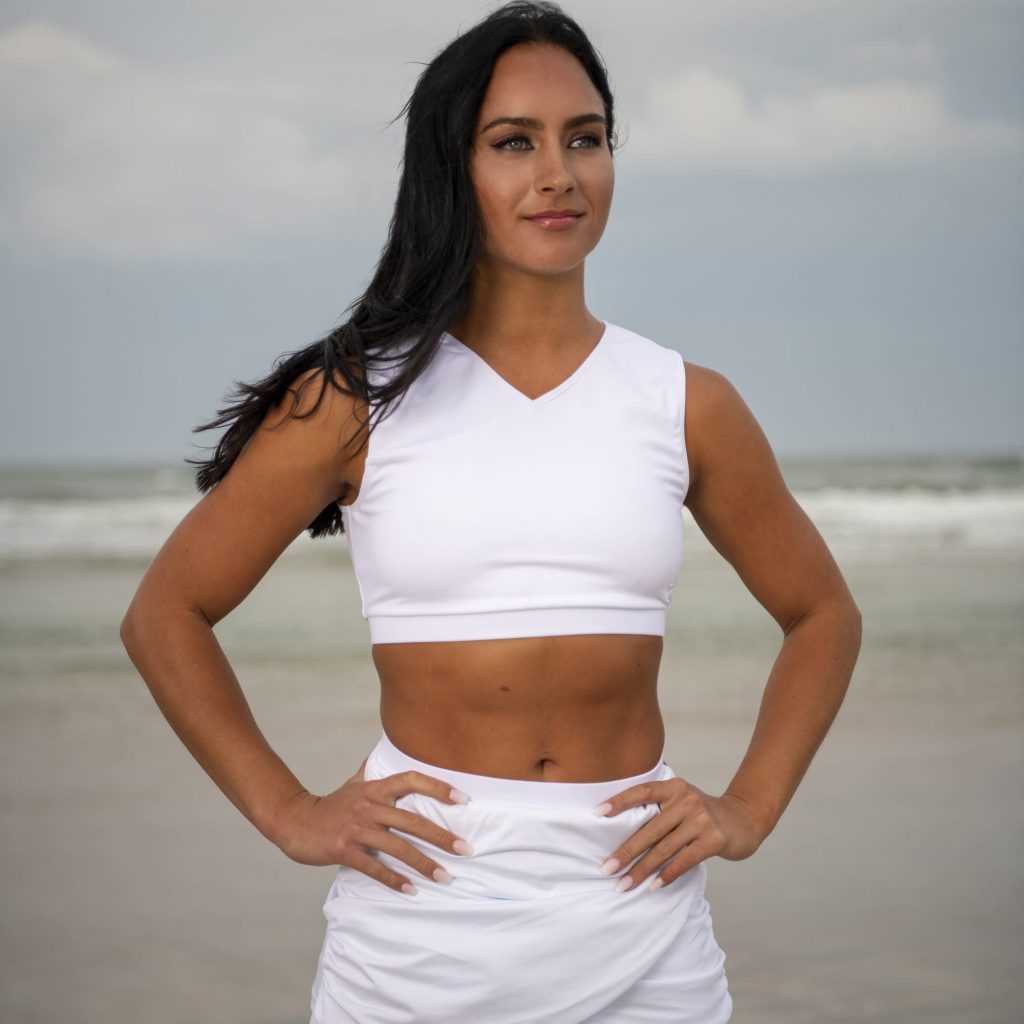Gabi Butler is back for Netflix’s second season of Cheer featuring Navarro’s famous squad, rival Trinity Valley Community College, and all the highflying stunts and full-outs to make your head spin. Butler’s last season with Navarro ended this past spring, and she’s since joined the cheer team at Utah’s Weber State University. (Note: barring a cancellation due to COVID-19, she will still take her talents to Daytona in 2022, just for a different division title.) This new squad, she told POPSUGAR, is known for its difficult stunts, but both Navarro and Weber State teams call for skills that you have to train “years and years and years” to get.
Performing on Butler’s level requires endurance and strength – watch Cheer episodes that chronicle “hell week,” and you’ll see just how much hard work it takes. Aside from “anything cardio related,” which the experienced flyer said she’s “super” into, she is a stickler for core. She thought back to when Coach Monica Aldama would have them do ab-focused conditioning during Navarro cheer practice. “[Aldama] would basically just be like, ‘OK, just go and do abs for like however long you can,'” Butler recalled, noting that when she could pick her own exercises, she’d do moves such as the following:
- V-up
- Side v-up
- Leg lift
- Seated knee tuck (or what Butler called “in-and-outs”)
- Wall handstand walk
Ahead, check out how to do each move. This is not a workout, just a list of Gabi Butler-approved core exercises you might want to add to your next sweat session. As a former gymnast, I’m reminded of exactly the type of moves we used to do for mid-practice conditioning. (So I’m basically a Navarro cheerleader . . . NOT!)
Related: Want to Know What a Core-quake Feels Like? Try Jordan Chiles’s and Simone Biles’s Ab Workout
POPSUGAR Photography / Sam Brodsky
V-Up
- Lie face up with your arms overhead and your legs extended, resting on the floor.
- Lift your hands and feet a few inches off of the floor into a hollow position, and keep your abs engaged by pulling your belly button into your spine and pressing your lower back into the floor.
- With control, lift your upper body and lower body simultaneously, reaching your arms toward your feet. Think of your body folding in half.
- Lower your arms and legs toward the floor to complete one rep. The more you bring your upper back off of the ground during the “V” part of the exercise and the lower you bring your arms and legs at the end of each rep, the harder the move will be.
POPSUGAR Photography / Sam Brodsky
Side V-Up
- Lie on your side with your arms and your legs extended. Bring your feet slightly in front of you so that you’re in a hollow position. You can put one hand down for support if you need (as seen here).
- While keeping your navel pulled into your spine, simultaneously lift your arm(s) and legs a few inches toward the ceiling.
- Lower back down to the floor with control. This completes one rep. Do the same amount of reps on each side.
POPSUGAR Studios
Leg Lift
- Lie flat on the ground with your legs extended straight up toward the ceiling. Place your hands underneath the back of your head. For added stability, you can place your arms out to the side, allowing your palms to grip the floor.
- Pressing your lower back into the ground and keeping your navel pulled into your spine, slowly lower both legs down toward the floor as low as they can go without breaking your form (and without touching the ground), then slowly raise them back up. If this is too difficult, lower one leg at a time.
- This counts as one rep.
POPSUGAR Photography / Tamara Pridgett
Seated Knee Tuck
- Start seated on the ground. Place your hands about an inch behind your back with your fingers facing forward. Your feet should be on the ground.
- Lift both feet up off of the ground and extend both legs as you simultaneously lower your upper body. Be sure to get full extension at your hips and legs.
- With control, bring your legs back to your chest without touching the ground with your feet (this is your tuck) and return to the starting position. This counts as one rep.
POPSUGAR Photography / Louisa Larson
Wall Handstand Walk
Butler said she likes to use a wall for what she calls “handstand walks” as a way to work her core and shoulders.
Step 1: Get Into Your Handstand
- Place your hands one leg length away from the wall.
- Step your feet on the wall so your shoulders are stacked over your wrists and your hips are stacked over your shoulders with your legs parallel to the floor. This is an “L-Stand” because you’re making an “L” shape with your body.
- Moving your hands closer to the wall, walk your feet up into a handstand with your toes pressing against the wall. Keep your core tight, and press up through your shoulders. Squeeze your glutes, and keep your feet together.
Step 2: Handstand Walk
- With your feet still on the wall, walk your hands one at a time away from the wall.
- Keep your core and glutes tight the entire time, and try not to break form by pushing through your shoulders.
- This editor recommends walking out with your hands four times (left, right, left, right). Then walk your hands back in so that you return to your handstand against the wall.
Note: if this is too difficult, you can hold an “L-Stand,” a handstand against the wall, or a high plank.

